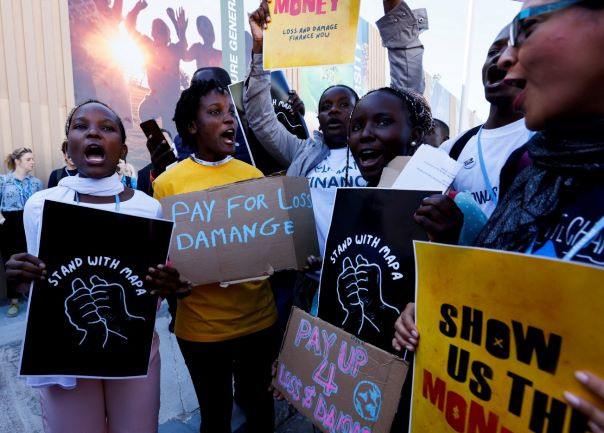Popular Reads
Top Results
Can't find what you're looking for?
View all search resultsPopular Reads
Top Results
Can't find what you're looking for?
View all search resultsTime for us to move the needle on climate finance
Tthe financial sector is rightly becoming more focused on the climate impacts of plastics and waste.
Change text size
Gift Premium Articles
to Anyone

After spending two days at the B20 and O20, it’s clear this year’s Group of 20 Summit came at a difficult time, in the aftermath of the COVID-19 pandemic, increased nationalism and heightened political tensions. Appropriately themed “Recover Together, Recover Stronger”, the underlying message is clear: We must mend our economies, planet and societies at the same time.
Central to this objective is the delivery of the crucial climate financing agenda. To deliver the investment needed against a diminishing window of opportunity requires an immense push on both the scale and quality of finance. Leveraging different pools of funding will be the catalyst for progress and strengthening cooperation is not a choice, but a must.
Described as the “litmus test” for COP27’s success, for the first time, delegates agreed to discuss loss and damage compensation for emerging economies. The June 2022 V20 Report, issued by the world’s most vulnerable countries, measured that over the last 20 years, the most at-risk economies lost over half their economic growth potential due to the negative effects of human-induced climate change; a staggering US$525 billion.
New research from the Independent High-Level Expert Group on Climate Finance commissioned by the COP26 and COP27 presidencies estimates that emerging markets need to unlock climate finance of over $$2 trillion per year by 2030 – half from external sources – meaning public sector commitments for reparation payments will not be sufficient alone. We need more private capital on the table to deal with loss and damage, prevent further climate catastrophe and create a sustainable, inclusive economy.
Globally, the equity market is valued at $120.4 trillion. The global debt market is approximately twice this. A fraction of this could be steered toward climate finance to significantly shift the needle.
There is no shortage of start-ups and SMEs creating impact – we have seen this in the plastic circular economy, where we focus as an investment firm. To capitalize on their potential, we must expose opportunities that are available and help tailor financial instruments to their needs, while also addressing the heterogeneous needs of local markets.
Throughout my work, it has been repeatedly confirmed to me that if we only search for the next big investment opportunity, we will miss high-potential opportunities that just need a little tailwind. Investment opportunities come in many shapes and forms, demanding flexibility in the form of financial instruments, investment size, tenure, and risk appetite.
Here in Indonesia, data reveals impact investors focus more on early stage and mature enterprises – a trend which is reflected in the wider investment community. However, this often results in a lack of funding for the “missing middle”- businesses that have passed their early development phase and that demonstrate a track record of profitability. Institutional investors can help to fill this void and accelerate action against climate challenges – especially as the “missing middle” businesses and projects are more likely to attest to a viable and scalable model.
Finally, investors can help to meet climate goals by seeking out opportunities in complementary industries. While there is an influx of sustainability-focused funds, this capital cannot all be injected into renewables. To provide an example, the financial sector is rightly becoming more focused on the climate impacts of plastics and waste. Applying an intersectional lens to investing in the environment will help us achieve goals faster.
Policymakers can provide greater certainty to private investors, setting the stage for increased commitment. In addition to facilitating capital through economic incentives that reduce risk, such as subsidies, grants and cost-sharing agreements, the introduction of supportive policy can create an environment for innovative solutions and business to thrive.
Additionally, development finance institutions, backed by governments, can help with de-risking investments and offering technical assistance to enhance the commercial viability of emerging start-ups and innovations.
A recent partnership between USAID Clean Cities, Blue Ocean program, Circulate Capital and Prevented Ocean Plastic Southeast Asia to expand plastic collection and recycling infrastructure in Indonesia, demonstrates how the strengths of development agencies and private investment can be leveraged to bring coordinated expertise and blended financing to solutions.
Public funds, impact and commercial investors now have a timely opportunity to use catalytic capital to mobilize greater participation. In the context of plastic circularity, catalytic capital has proven its efficacy; we can now showcase its potency by expanding to all climate related challenges.
The next few years are critical for the future of our planet. We have an opportunity to leverage global attention and urgency, as well as participation from stakeholders – governments, financial sector, multilateral agencies and more – to shift the trajectory and deliver a positive story of sustainable development.
G20 member countries – which account for 80 percent of the world’s economic output, two-thirds of the global population, and 75 percent of global greenhouse gas emissions – must lead the charge.
***
The writer is managing director, Asia, Circulate Capital.











